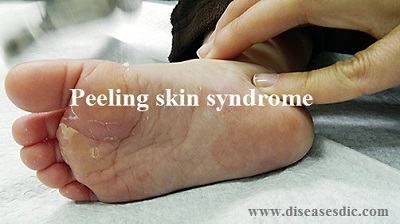Definition
Peeling skin syndrome is a group of rare inherited skin disorders characterized by painless, continual, spontaneous skin peeling (exfoliation) due to a separation of the outermost layer of the epidermis (stratum corneum) from the underlying layers. Other findings may include blistering and/or reddening of the skin(erythema) and itching (pruritus).
Symptoms may be present from birth or appear in early childhood. Based on the extent of skin involvement, two forms of peeling skin syndrome are recognized: a generalized form involving the entire integument, and an acral form involving only the extremities, and mostly hands and feet.
Generalized peeling skin syndrome may clinically overlap with Netherton syndrome, which is another autosomal recessive skin disorder belonging to the group of congenital ichthyoses, with onset in the neonatal period and infancy.
Types
There are two main types of the generalised Peeling Skin syndrome:
Type A (non-inflammatory) PSS
- Generalised asymptomatic peeling of the trunk, limbs and occasionally the face
- Histological examination shows an orthokeratotic epidermis with a separation that occurs either within the lower part of the stratum corneum or just above the granular layer
Type B (inflammatory) PSS
- This is by erythematous migratory patches with a peeling border, pruritus, and a tendency towards atopy
- Histology can show an absence of the stratum corneum or a few layers of parakeratosis, which tend to be separated from the stratum granulosum. Psoriasiform acanthosis and perivascular infiltration with mononuclear leucocytes can also be seen
Causes
- This is characterised by erythematous migratory patches with a peeling border, pruritus, and a tendency towards atopy
- Histology can show an absence of the stratum corneum or a few layers of parakeratosis, which tend to be separated from the stratum granulosum. Psoriasiform acanthosis and perivascular infiltration with mononuclear leucocytes can also be seen
Your skin is regularly exposed to environmental elements that can irritate and damage it. These include sun, wind, heat, dryness and excessive humidity. Repeated irritation can lead to skin peeling. In babies born past their due date, it’snot unusual for them to experience some painless skin peeling.
Skin peeling can also result from a disease or condition, which may start other than your skin. This type of skin peeling is often by itching. Conditions that may cause skin peeling include:
- Allergic reactions
- Infections, including some types of staph and fungal infections
- Immune system disorders
- Cancer and cancer treatment
- Genetic disease, including a rare skin disorder called acral peeling skin syndrome that causes painless peeling of the top layer of skin
Symptoms
Some of the symptoms of Peeling skin syndrome:
- Abnormal blistering of the skin
- Aminoaciduria
- Dry skin
- Ichthyosis
- Abnormality of hair texture
Symptoms of peeling skin syndrome
Diagnosis
- A good history and physical exam are often sufficient to make the diagnosis, although specialized tests including surgical removal and microscopic evaluation (biopsy) of affected tissue may be necessary at times.
- The continual shedding of large sheets of skin distinguishes peeling skin syndrome from Netherton syndrome and from other types of autosomal recessive congenital ichthyosis, such as congenital ichthyosiform erythroderma.
- The skin of so-called “collodion babies” peels off after a few weeks and does not return, in contrast to patients with peeling skin syndrome whose symptoms return time after time.
Treatment
- Treatingpeeling skin syndrome by applying skin softening (emollient) ointments, especially after a bath while the skin is moist, may offer some relief.
- Plain petroleum jelly or Vaseline is preferred. None of the corticosteroids or systemic retinoids (vitamin A derivatives) is indicated or effective and all may have serious side effects or adverse reactions.
Prevention
- Preventing sunburn in the first place is the best way to prevent the skin from peeling due to sunburn.
- One of the simplest ways to prevent sunburn is to apply an appropriate sunscreen before going outside, even on overcast days. Other tips include limiting the time spent in the sun and wearing long-sleeve shirts and pants.
- If it is already too late, however, head indoors as soon as possible and grab the aloe vera. Apply liberally to any part of the skin that may be affected. Aloe vera not only slows but also helps prevent peeling.
- If possible, take a cool shower and apply the aloe vera or another suitable moisturizer immediately after. Skin absorbs maximum moisture when it is damp

